Jiahu Bone Flute of Prehistoric Bone Flute Culture
Bone flute is a kind of flute and the earliest musical instrument. Also known as eagle flute or eagle bone flute, Tibetan, Tajik, Kirgiz edge air-sounding musical instruments, called Dangja in Tibetan. Made of eagle wing bones, it is popular in Tibetan pastoral areas such as Tibet, Qinghai, Yunnan, Sichuan and Gansu. Often used for solo. It is a self-entertainment wind instrument favored by Tibetan youths. It is mostly played for self-entertainment during grazing or field work in summer.

Jiahu Bone Flute, as the earliest playable musical instrument discovered in the world, is the first of the "Nine Treasures of the Town Courtyard" in Henan Museum, and it still exudes a charming brilliance. So why does it get this honor?
The story has to start in 1979. One day in the autumn of that year, in Beiwudu Town, Wuyang County, Henan Province, Jia Jianguo, a primary school teacher in Jiahu Village, led his students to level the land outside the embankment. He was surprised to find stone axes, shovels and broken pottery pieces scattered on the ground. Jia Jianguo guessed that these might be relics from the Neolithic period, so he sent them to the county museum. Jia Jianguo would not have thought at the time that his move led to the Jiahu site, one of the "100 great archaeological discoveries in China in the 20th century". In a tomb numbered M282, a well-preserved skeleton and more than 60 funerary objects were found. Archaeologists speculate that the owner of the tomb may have been a wizard or a tribal chief during his lifetime. On the left thigh of the owner of the tomb, there is this bone flute.
The final test showed that the bone flute had been sleeping in the ground for eight or nine thousand years, which surprised everyone. After sound measurement, the bone flute not only has a scale structure, but also can play traditional pentatonic or seven-tone music. It is an ancient musical instrument. According to the identification of zoologists, the bone flute is made of the ulna of cranes. The ulna of birds is thin-walled and hollow. If the joints at both ends are cut off, it is an ideal vocal tube, which is very suitable for making a flute.
The data proves that, so far, Jiahu bone flute is the earliest and most well-preserved musical instrument in the world that can be played. It is two thousand years earlier than the flute that appeared in ancient Egypt. It is called the originator of Chinese wind instruments. This is also another major archaeological discovery after Chinese music archaeology relayed the chimes and chimes of the tomb of Zenghou Yi in Hubei. This Jiahu bone flute is yellow-brown and beautifully made, with a total length of 23.1 cm. There are seven circular sound holes drilled on the body of the flute, with a diameter of 0.35 cm, which are evenly distributed. Seven tone scale. Among the more than 30 Jiahu bone flutes discovered at the moment, it is the one that is completely preserved and can be called "the first flute in China".
The earliest musical instrument excavated in my country is the Jiahu bone flute in Wuyang County, Henan Province, which belongs to the Neolithic period. It is about 20 cm long and has seven sound holes of the same size and a small hole at the top of the last hole. It has a history of more than 8,000 years. Then there is the Neolithic bone whistle unearthed in Hemudu, Yuyao, Zhejiang. There are 160 bone whistles in this batch, with a history of more than 7,000 years. The so-called bone whistle is made from the limb bones of large birds, cut off two ends, and grind one or two or two or three blow holes in the bone tube. This bone whistle can make a few simple tones. Bone whistle is used to trap prey or to play music. This has always been a question that modern people are thinking about. Judging from the production and development of primitive people, the bone whistle may be used both. It is not only used to trap prey, but also to play for fun in leisure time. Of course, the role of the bone whistle should still be based on the former. The earliest musical instruments discovered by archaeology are not the earliest musical instruments produced.
 渝公网安备 50010702504639号
渝公网安备 50010702504639号